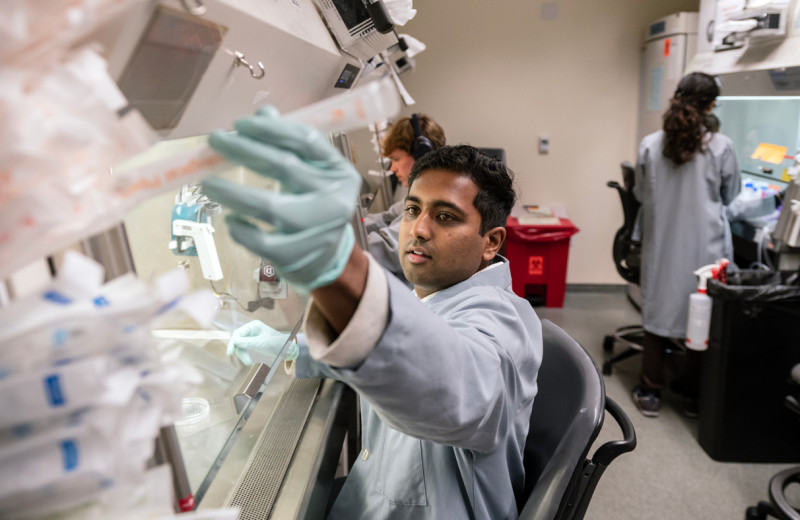Gladstone NOW: The Campaign Join Us on the Journey✕

Nevan Krogan (left) and Alex Marson (right) led a study to better understand how HIV hijacks human cells and ultimately help identity new classes of drugs against this virus.
Like all viruses, human immunodeficiency virus (HIV) is unable to replicate on its own. To replicate, it hijacks the molecular machinery found within the host cells it infects. In a study published in Nature Communications, a team from the Quantitative Biosciences Institute (QBI) at the UC San Francisco (UCSF) and Gladstone Institutes reported that they had created a functional catalog of these hijackings, providing a new window into HIV biology.
To do this, the scientists used CRISPR-Cas9 gene editing to create a functional map of the interactions between HIV and human T cells isolated from blood. Of the 86 proteins they identified that alter HIV infection, about half were previously unknown.
The investigators say this study opens the door for new research into these interactions and for ultimately developing novel drugs to block them. The study also provides important validation of using CRISPR technology to study virus-host interactions directly in human T cells, a new area of research.
“Existing antiviral drugs have been incredible at decreasing the replication of HIV in the body, but these drugs have a number of shortcomings, including the fact that people are tied to taking them for the rest of their lives,” says the study’s co-first author Judd Hultquist, PhD, who is now an assistant professor in the Feinberg School of Medicine at Northwestern University, and conducted the research while he was a postdoctoral fellow in the lab of Nevan Krogan, PhD, at UCSF and Gladstone. “For us to find a functional cure, we need to better understand how the virus is replicating in the human body.”
For this research, the investigators focused on protein-protein interactions. Specifically, they looked at the 426 human genes that encode proteins that had previously been demonstrated to interact directly with HIV. They used CRISPR-Cas9 to systematically knock out each gene and then looked at the effect each gene deletion had on virus replication. They found that the absence of some genes made replication go up, while others made it go down.
“This allowed us to map very specifically how HIV interacts with all of these human proteins,” says co-first author Joseph Hiatt, an MD/PhD student in the labs of Krogan and Alex Marson, MD, PhD. “When you find these new host factors, they point to avenues for new classes of drugs. It’s an incredibly powerful and valuable approach to learning how HIV hijacks cells.”
The investigators focused on this project for more than 6 months, often working day and night. Using T cells obtained from human donors’ blood, they painstakingly knocked out each gene and studied how it affected HIV.
“This work required so much vision from Nevan and Alex to gather all these resources and bring together these separate lines of technology in a way that can really shed light on an important human condition,” Hiatt says. “It provides an approach for studying protein-protein interactions more broadly, including in cancer and other types of infections.”
“For the past two years, the world has been fixated on the ongoing COVID-19 pandemic, while other epidemics have faded into the background,” Hultquist says. “But there are currently 38 million people living with HIV, including 1.5 million new infections that occurred in the past year. We have the technology to better answer basic questions about HIV biology and we need to use them to develop new therapeutic strategies. We do not want HIV to become the forgotten epidemic.”
Source: Quantitative Biosciences Institute
Gene Editing Strategy Could Treat Hundreds of Inherited Diseases More Effectively
Gene Editing Strategy Could Treat Hundreds of Inherited Diseases More Effectively
Scientists at Gladstone show the new method could treat the majority of patients with Charcot-Marie-Tooth disease.
News Release Research (Publication) Neurological Disease Conklin Lab CRISPR/Gene EditingGenomic Maps Untangle the Complex Roots of Disease
Genomic Maps Untangle the Complex Roots of Disease
Findings of the new study in Nature could streamline scientific discovery and accelerate drug development.
News Release Research (Publication) Marson Lab GenomicsThe Genome Editing Playbook Is Different in Neurons
The Genome Editing Playbook Is Different in Neurons
The striking findings of a new study could influence how gene therapies are designed for many genetic diseases.
News Release Research (Publication) Neurological Disease Conklin Lab Doudna Lab CRISPR/Gene Editing





